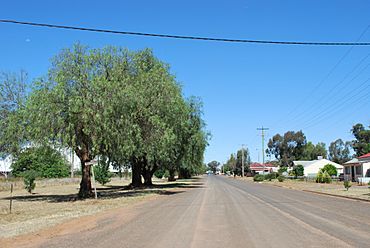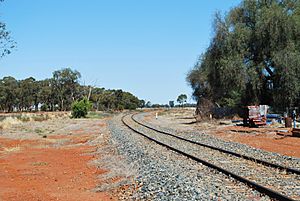Tullibigeal facts for kids
Quick facts for kids TullibigealNew South Wales |
|
|---|---|

Cargelligo Street in Tullibigeal
|
|
| Population | 263 (2021 census) |
| Postcode(s) | 2669 |
| Elevation | 296 m (971 ft) |
| Location |
|
| LGA(s) | Lachlan Shire |
| State electorate(s) | Barwon |
| Federal Division(s) | Parkes |
Tullibigeal is a small town in the Central West part of New South Wales, Australia. It's mostly a farming area. In 2021, about 263 people lived there.
Contents
What's in a Name?
The name Tullibigeal comes from an Aboriginal word. It means "yarran wooden spears." A yarran is a type of acacia tree that grows in the area.
A Look at History
Tullibigeal got its own Post Office on April 1, 1918. Before that, in 1917, the railway reached the town. This helped connect Tullibigeal to other places.
Who Lives Here?
In 2021, 263 people lived in Tullibigeal and the nearby areas. The people living here are a bit older than the average Australian. Also, most people in Tullibigeal were born in Australia. About 86% of residents speak only English at home.
Many people in Tullibigeal are Christian. The main Christian groups are Catholic, Uniting, and Anglican. About 20% of the people said they have no religion.
How People Make a Living
Farming is the main way people earn money in Tullibigeal. About 62% of the workers are involved in farming. They raise sheep and cattle, and they also grow grain.
The grain grown here is sent out by train. There are big grain silos right next to the railway tracks in town. These silos help store the grain before it's shipped to places like Lake Cargelligo and Temora.
Famous People from Tullibigeal
Some well-known people have connections to Tullibigeal:
- Barry Glasgow played rugby league for teams like Western Suburbs and North Sydney in the 1960s and 1970s.
- Singer Shannon Noll grew up on a farm near Tullibigeal. He went to the local school in town.
- Avon “Garry” Garrard was a local policeman from 1953 to 1956. He later became a senior police officer. He is remembered for encouraging police to walk the streets and connect with their communities.
Images for kids






